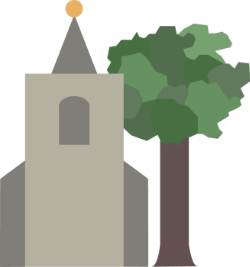We are delighted to announce that the building repair works are complete and that from Sunday 26th May, services will resume in the church. With huge thanks to everyone who has supported the project in so many different ways. We are so excited that St Mary’s will once again be open to everyone.
On 13th August 2017, the Rev’d Dr Lynne Broughton gave a talk to members of the Cambridgeshire Historic Churches Trust on the history of the church, describing many interesting aspects of the building, including the murals. You can watch a video of the talk, including pictures of the features described, on YouTube.
The Church itself is built largely of field stones. Historians believe, using evidence from the shape, design and setting of the last window on the south side of the chancel, that there was an earlier church on the site. The vestry of St. Mary’s is modern, but the rest of the church dates from the early fourteenth century. The tower, nave and chancel were completed in the late fourteenth century, the south porch in the late fifteenth, and the unusual queen-post roofs are fifteenth century (queen-posts are vertical wooden posts on either side of the centre). During this period, the chancel arch was rebuilt to make it larger, and a stone stairway was constructed in the north east corner of the nave. The original rood screen, the carved screen which separates the nave and the choir, seems to have been removed at the time of the Reformation and replaced by another of Jacobean design in the early seventeenth century.
At one time a distinctive and richly-coloured medieval mural painting covered the whole south wall of the nave of the church. It was probably painted between 1460 and 1480. It was uncovered in 1858 during restoration work, examined and covered again until the restoration of 1986, when part of it was once more uncovered and restored, and is still visible. For more details see here.
The Diocesan records state that by 1783 the church was badly in need of repair and that the spire was out of line. Records in 1836 claim that the roof had so many holes that it gave good ventilation to the church and also admitted numbers of sparrows to the services. Restoration was begun in 1901 financed by members of Pembroke College, Cambridge. Parish registers date from 1569 and are virtually complete.
There were three bells and a sanctus bell in the tower in 1552. New bells are said to have been cast in 1797. All but one was sold and the remaining one was recast and rehung in the refurbished belfry around 2000. The font is on a modern base but it is believed to date from the thirteenth century although it has been reworked. The church has a cup and a communion plate, or paten, from 1569. On the chancel arch there is some scratching in Old English ‘MARMADUKE MESSYNDEN OFF HELYNGE YN THE CONTY OF LYNCOLNE’ that is ‘Marmaduke Messynden from Helynge in the County of Lincoln.’
Graffiti has been popular for much longer than we thought, ‘Helynge’ is probably the town of Hemmingby where the visitor came from. Rather more religious inscriptions are to be found on the western side of the south door where six lines in Latin are partly obliterated. The words ‘A SUBITA PESTE’ and ‘DIE DICTO’ can still be distinguished. This means ‘from sudden plague’ and ‘on the day spoken of’, which may be a reference to either the day of Judgement or to the Resurrection. On the second window of the south wall of the nave there is a medieval sundial. In the Churchyard, about fifteen feet south of the southern entrance, there is a tomb chest whose sides are now below ground level. It is said to contain the body of William Middleton who was rector until 1613. There are a number of eighteenth century headstones and footstones.
The church is a Grade II* listed building.
